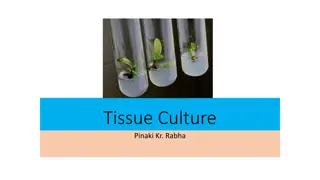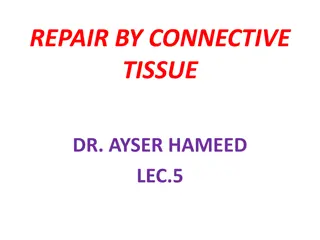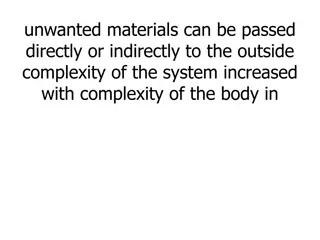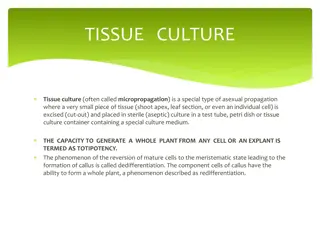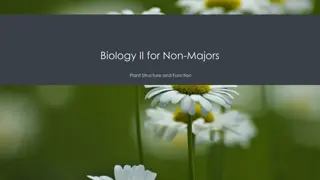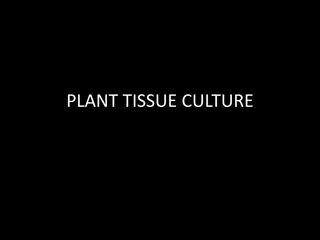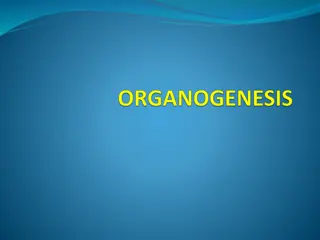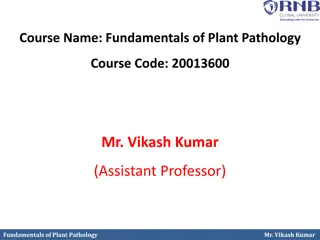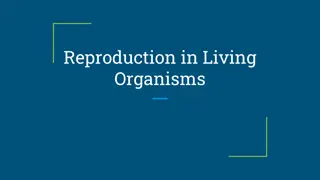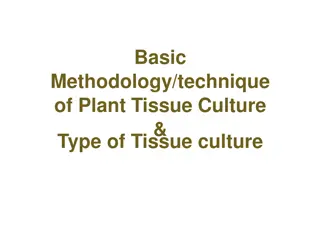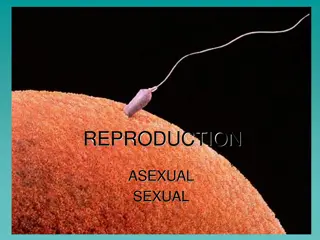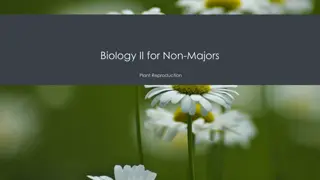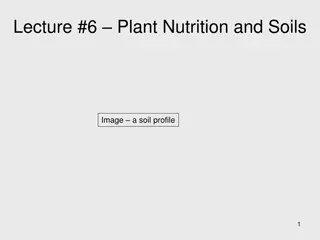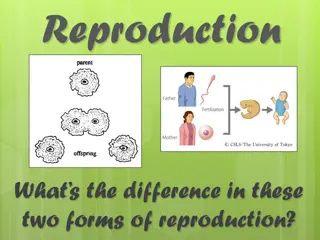Plant Tissue Culture Methods for Growth and Reproduction Study
Plant tissue culture methods such as root tip culture, shoot-tip culture, leaf culture, flower culture, and anther and pollen culture allow for the study of growth, reproduction, and genetic variations in plants. These techniques involve culturing various plant parts under sterile conditions to investigate factors influencing plant development, nutritional requirements, and reproductive processes. Each method serves a specific purpose in understanding plant physiology and can help in producing virus-free plant materials.
Download Presentation

Please find below an Image/Link to download the presentation.
The content on the website is provided AS IS for your information and personal use only. It may not be sold, licensed, or shared on other websites without obtaining consent from the author. Download presentation by click this link. If you encounter any issues during the download, it is possible that the publisher has removed the file from their server.
E N D
Presentation Transcript
2. a) Depending on the part used for culture Organ Culture i. Root tip culture (Meristem root tip culture) Root apical meristem is mainly responsible for the growth of roots by cell division, cell enlargement and cellular differentiation. Tips of the lateral roots are sterilised, excised and transferred to fresh medium. The lateral roots continue to grow and provide several roots, which after seven days, are used to experimental cultures. By this culture method it is possible to study the nutritional requirements of roots, shoot and root growth, conditions required for the development of secondary vascular tissues, lateral root and bud formation, nodulation etc. 43
ii. Shoot-tip culture (Meristem shoot tip culture) The shoot apex or shoot-tip (100-1000 m long) consists of the apical meristem and one to three adjacent leaf primordia. Actively growing shoot-tip is surface sterilized and is placed on a defined culture medium under sterile conditions. Shoot Node culture is simplified form of shoot culture, which is yet another method for production from pre-existing meristem. It is the simplest method but is associated with the least genetic variation. Some of the crop species that have been freed of viruses by this technique, they include soyabean, sweet potato, sugar cane and rhubarb. This method is used with both monocot and dicot species. 44
iii. Leaves or leaf primordia culture The growth of leaves on the culture medium depends upon the stage of the leaves during excision. It is observed that explants from immature young leaves grow better than explants from older leaves. Leaves (800 m long) may be detached from shoots, surface sterilized and placed on a solidified medium where they will remain in a healthy conditions for a long period. It is believed that leaf culture depends upon the physiological state and the age of the leaf. The shoot forming potentials differ in the leaf cultures as per the derivation of the explant and the hormonal factors involved. 45
iv. Flower culture (Meristem - floral culture) Flowers two days after pollination are excised, sterilized by immersion in 5% calcium hypochlorite, repeatedly transferred medium. When fruits are obtained on medium supplemented with growth hormones. Flowers excised before do not produce fruits. washed to culture with tubes containing an sterilized water and agar cultured, such flowers produce fruits. Larger pollination This microclimates or nutritional effects on the and reproductive processes of the plant. culture system is useful in studying vegetative 46
v. Anther and pollens culture Young flower buds are removed from the plant and surface sterilized. Immature stage of anther or late stage of filled pollen usually grow abnormally or the ineffective and hence for better response always select mature anther or pollen. The anthers are then carefully excised and transferred to an appropriate nutrient medium. The anthers are generally cultured on a solid agar medium where they develop into embryoids for anther culture under alternate light and dark period. Anther culture Pollen grains removed from the anther either mechanically or by naturally dehiscence. Anthers placed in 5 ml of liquid medium in a petri dish containing pollen grains with parafilm and incubated. After developed. anther containing starch development is generally or pollen grains of different species have been successfully to obtain large number of haploid plants. in the culture media are sealed incubation haploid plantlets are 47
vi. Ovule and embryo culture Mature embryos are excised from ripened ovule/seeds and cultured mainly to avoid inhibition in the seed for germination. Very small globular embryos require a delicate balance of the hormones. Embryo is dissected from the ovule/seed and put into culture media. This type of culture is relatively easy as the embryos require a simple nutrient medium containing mineral salts, sugar and agar for growth and development. Also, multicellular immature cultured aseptically to obtain is rescued, two genomes are to produce a fertile plant. By this method dormancy period of seeds can be shortened, as well as haploids can be produced. By ovule culture, it is possible to grow, study various nutritional requirements and stages young embryos or zygote. embryos are dissected out and viable hybrids. Once the embryo needed to be combined together 48
vii. Ovaries culture Ovaries excised after pollination can produce fruits on a simple medium containing mineral salts, sugar and vitamins. Ovaries taken from un-pollinated flowers fail to produce fruits on such a simple medium but can develop into seedless fruits hormones. By this culturing method can be studied. Haploids can be produced. Rare hybrids can also be produced by ovary culture. Dormancy period of seeds can be reduced. on a medium supplemented with physiology of fruit development 49
viii.Nucellus culture Nucellar tissues excised from unfertilised ovules have no adventitive containing medium malt embryoids are germinate. embryoids. If cultured on a extract are formed but they and adenine, unable to When such embryoids are excised and cultured on a medium containing gibberellin, plantlets may be formed which can then be transplanted to the field. Disease-free culture. clones can be obtained by nucellus 50
ix. Seed culture The seeds are treated with 70% alcohol for about two minutes, washed with sterile distilled water, treated with surface sterilizing agent Once again rinsed with sterilized distilled water and kept for germination by placing them on double layers of pre- sterilized filter paper, placed in petri-dish moistened sterilized distilled water or placed on moistened cotton swab in petri-dish. The seeds are germinated in dark at 25-28 C and small part of the seedling is utilized for the initiation of callus. for specific period. with x. Cotyledon culture Immature cotyledon develops into somatic embryos, shoot buds and complete plants if cultured on a suitable nutrient medium. 51
xi. Endosperm culture If endosperm is cultured on a proper nutrient medium continued proliferation of callus mass takes place and subsequently plant is regenerated. It is useful for plant breeding and horticultures. It also useful in the production of plantlets as an alternative to the conventional methods of crossing i.e. tetraploids with diploids or triploids which is applicable to fruit trees. induction 52
xii. Fruit culture The culture of fruit tissues as whole organ or isolated tissue section such as ovary has been successfully to mature fruits e.g. strawberry. Usually when an isolated portion of the into a sterile environment. It immediately loses structural integrity rapidly dividing callus mass. Loss of structural integrity is associated alteration of physiology that is subsequently reflected in the production of an altered metabolism. So it is not possible to make a meaningful study of fruits developing using callus derived culture. The use of fruit culture is to serve as a bioassay system to study fruits maturation events within a controlled environment. cultured to give rise fruit tissue is introduced and degenerates into a correspondingly with an xiii. Plant cell culture Culture of isolated cells or very small aggregates remaining disperswed in liquid medium. 53
b) HAIRY/ TRANSFORMED ROOTS (TRANSINFECTION) Certain soil bacteria of the genus Agrobacterium (Gram negative bacteria) infects a wide range of plant species and causes the infection in plant termed as Hairy root disease. The disease is transformed bye their genome t-DNA from a bacterial plasmid to plant hairy root cells. A large number of small fine hairy roots covered with root hairs originated directly from the explant in response to Agrobacterium rhizogenes or Agrobacterium tumefaciens. The hairy roots are produced by inoculating the host plant when grown in a hormone-free medium give rise to copious roots referred to as 'transformed roots' or 'hairy roots'. These are fast growing, highly branched adventitious roots at the site of infection. They are genetically stable and affect a wide range of dicotyledonous plants and have same metabolic features. 54
Establishment/Methodology of Hairy Root Culture The explant material is Agrobacterium rhizogenes generated by growing bacteria in YMB medium for two days at 25 C with gyratory (round circle) shaking, pelleting by centrifugation (5 10 rpm; 20min) and suspending the bacteria inYMB medium to form a thick suspension. Transformation may be induced as asceptic plants grown from seeds, of on detached leaves, leaf discs, petioles of stem segments from green house plants following sterilization of excised tissue with 10% (v/v) domestos for 20 minutes. Scratching the midrib of a leaf or the stem of a plantlet, with the needle of a hypodermic syringe containing the thick bacterial suspension allows inoculation with small (about 5-10 l) droplets containing Agrobacteriumrhizogenes. In some species a profusion of roots may appear directly at the site of inoculation, but in other a callus will form initially and roots emerge subsequentlyfrom it. In either case hair rot normally appear with in 1-4 weeks although the susceptibility of species to infection is variable. inoculated with a suspension of 55
Advantages of Hairy Root Culture Genetic and growth kinetic stability over prolonged period of growth in vitro. Ease of culture in vitro phytohormones. Many plant cell culture systems, which did not produce adequate amount of desired compounds is being reinvestigated using hairy root culture methods. A diversified range of plant species has been transformed using various bacterial strains. Plant regeneration, plant improvement and genetic manipulation in plant can be done. Reproducible & predictable levels of product synthesis. Capability to synthesize (novel) secondary metabolites specific to that plant species from which they have developed in equal or even higher amount compared to field grown plants. More accumulation of secondary metabolites. Eg. Levels of steroidal alkaloid solasodine is significantly higher in hairy root cultures than callus or suspension cultures. using simple media lacking 56
Problems associated with Hairy Root Culture Excess bacterial growth. Slow regeneration. Decreased cell division and transformation due to stress. No transformation. Loss of gene effects. Applications of Hairy Root Culture Sr. No. 1 Artemisia annua 2 Hyoscyamus muticus 3 Nicotiana tabacum 4 Podophyllum spp. 5 Panax ginseng 6 Solanum aviculare 7 Withania somnifera 8 Valeriana wallichi Plant Product obtained Artimisinin Hyoscyamine Nicotine,Anatabine Lignans Polyacetylene analogues Solasodine Withanolides Valpotriates 57
c) Protoplast culture Protoplast are plant cells with a plasma membrane but without cell wall, because of this the protoplast provide the starting point for many of the technique of genetic manipulator of plants, in particular the induction of somaclonal variation, somatic hybridization and genetic transfer. They are cultivated in liquid as well as on solid media. Isolation of Protoplasts is by two methods. Protoplasts can be isolated from almost roots, leaves, fruits, tubers, root cells, and cells of callus tissue. 1. 2. Enzymatic method all plant parts i.e., endosperm, pollen nodules, Mechanical method 58
1. Mechanical method The cells were kept in a suitable plasmolyticum (lysis of plasma membrane) and cut with a fine knife. Cells were cut only through the cell wall, releasing intact protoplast. This mechanical procedure gave low yield of protoplasts and could be utilized for only highly vacuolated cells. and non meristematic The method is laborious and tedious. 59
1. Mechanical Method Cells Plasmolysis Plant Tissue Microscope Observation of cells Release of protoplasm Cutting cell wall with knife Collection of protoplasm
2. Enzymatic Method Leaf sterilization, removal of epidermis Filtration through Nylon mesh Macroenzyme (Pectinase) in 13% Mannitol Isolated cells + 2% Cellulose 1 and a half hour Cellulose + Pectinase 2-3 hrs at 20-22 C Protoplast
2. Commercial preparations of purified cell wall degrading enzymes such as macroezyme, cellulase and hemicellulose became available that gave further progress to enzymatic isolation of protoplasts. By this method very large number of protoplast are obtained compared to mechanical method. Cells are not damaged or broken Osmotic shrinkage of protoplast is much less. Enzymatic method Enzymatic method of protoplast isolation can be classified into two groups. 2.1 Sequential enzymatic This involves two steps where first macerated plant tissues are incubated with pectinase to get single protoplast. cells followed by cellulase treatment to get 2.2Mixed enzymatic This involves simultaneous separation of cells and degradation of their walls to convert protoplast by immersing plant tissues in mixture of pectinases and cellulases. 62







